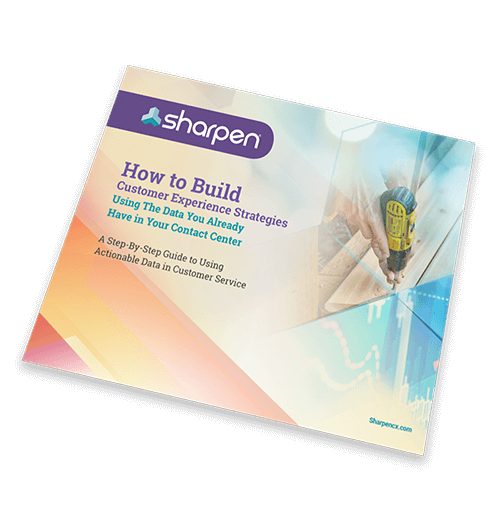
A Data Framework to Find (and Fix) Gaps in Your Call Center Technology and Customer Experience
Data. Analytics. Usability. Omnichannel strategy. If you’re a contact center leader, you probably hear – and use – these buzzwords all the time. But if you’re like most contact center leaders, you know these buzzwords carry a lot of weight. Data and analytics power your contact center. Yet still, some leaders are stuck scratching their heads, trying to figure out how to harness all the power of the data sitting in their call center technology.
On-demand service and next-day delivery made customer expectations skyrocket. Now customers assume they can – and should – get the same level of service everywhere. What’s more? Customers know they can turn to your competitors if they aren’t satisfied with your service.
As a contact center leader, you’re plenty aware that the keys to CX success lie in your people, first, but that your data, digital strategy, and technology play critical roles, too. With all those competing priorities, it can be hard to know where to take the first step in launching a new and improved CX strategy.
The encouraging part is that you’re not alone: 99% of contact centers don’t think their data intelligence strategy meets business needs. But don’t let that statistic hold you back from trying. According to a study at the University of Texas, Fortune 1000 companies can see an average revenue boost of $2 billion annually if they improve data usability by 10%.
To improve your CX, you need to put your data to work for a holistic, 360-view of your customers. And to get there, you need to unify your call center technology so your data can work for you. Here’s a step-by-step data framework to unify your call center technology and deliver a better customer experience.
[Read Next] 4 projects that will boost your customer and agent experience
1. Gather data to identify where gaps live in your call center technology
The first step in using your data is finding it. Seem obvious? Not if you’re working with siloed systems and outdated technology. Finding actionable data can be tough if your technology isn’t unified. When your CRM, ticketing system, and call center platform all have different customer information, it’s hard to get an accurate picture of what’s happening with your customers.
Taking the first steps to gather historical and real-time data not only shows the strengths in your current technology systems and data collection. It also reveals weak spots. If you have modern call center technology, you might find your data is already sitting there, untapped and waiting for action. If you have outdated systems that don’t communicate well with one another, you start to see the silos that keep you from improving your customer experience.
Ask yourself and your leaders questions to get a feel for what you have and what you’re missing with your current reporting engine. Your questions should cover different areas of your business.
Here are a few questions to learn where gaps exist in your CX and call center technology:
1. Customer demographics and preferences
- Who are my customers?
- What channels do they use? Are there differences in channel preference based on their age?
- How often do customers call in? Are they asking simple questions that could be resolved elsewhere?
- Can I report on all the channels my customers use?
- Does my call center technology allow me to solicit customer feedback?
2. Agent-customer interactions
- What are my agents’ handle times?
- How many calls do my agents get through in a day? An hour?
- What questions do my agents struggle to answer?
- What’s my call transfer rate?
- Can I share data with my agents daily?
- Can my supervisor customize reports with both historical and real-time data?
[Read Next] 6 reporting metrics that will level up your customer service
2. Analyze your data to better understand your customers
Once you have a good grasp of your data, review and analyze it to see where gaps in your customer journey exist and where call center technology can help you bridge those gaps.
Ask yourself what your data tells you about:
- Your customers’ needs and interests
- What your customers are saying about your business. Did you know a whopping 93% of customers turn to online reviews to decide if a business is worth their money or not? So, it’s important to have a grasp on your outside reputation.
- Your customers’ frustrations. Are they satisfied or not? Do you notice any patterns in customer complaints?
- Your agents’ performance. Are your agents working efficiently and effectively?
- Does your call center technology help you with performance management, giving you the data you need to effectively train agents?
- What does your data tell you about where you need to coach and develop your teams? And, how does your technology help get you there?
Make a list of top KPIs to analyze so you know what to look for in your data and how to connect it back to your contact center technology. Use Gartner’s five KPI categories for customer experience as your guide.
Then, ask yourself questions related to each KPI:
1. Employee engagement:
- How engaged are my agents?
- What is our turnover rate?
- How are my agents’ relationships with each other? With their managers?
- How does my call center technology help my agents with their work?
- Do they get frustrated with current processes?
- Do they have systems that are easy to understand and navigate?
2. Quality operations:
- How many support requests do we receive daily or weekly?
- Do we meet our SLA agreements for every channel?
- Can we adequately forecast and staff for customer needs?
- Does our call center technology offer tools to help predict service levels and keep up with customer expectations?
3. Customer satisfaction:
- What’s our First Call Resolution Rate?
- How long do we make customers wait on hold?
- Can we collect CSAT scores and customer feedback with our call center platform?? How many abandoned calls do we see daily?
4. Loyalty churn retention:
- Are my customers sticking around?
- How many customers leave after one purchase?
- What’s our average lifetime customer value?
- As our customer journey evolves, can our call center technology evolve with it?
5. Advocacy brand reputation:
- How’s our online reputation?
- Are we gathering NPS and CSAT scores on the channels our customers care about?
- Can we use social media for social listening?
Look for trends and triggers in your data so you get a grasp on the entire customer journey and how your call center technology helps (or hurts) it.
[Read Next] Use cloud call center technology to reduce customer service inefficiencies
3. Use your data analysis to make improvements to your CX strategy and technology
This is where you decide what to do with your data and what updates (if any) you need to make to your call center technology. If your goal is to create a better’ CX, determine ways to better understand your customers and how tech helps you improve. One of the simplest ways to do that is to listen to them directly.
Create a feedback loop with your customers so you’re constantly listening to and responding to their insight. Use your call center platform to send out CSAT surveys and encourage customer feedback.
Here are a few tips to get customer survey feedback:
- Asking customers directly after each interaction
- Automating surveys to send within 24 hours
- Explaining why their feedback matters to you and how it helps them
- Using intelligent customer data to inform when and how often to send surveys
Ask questions that put the focus on customers, like:
- How would you rate the quality of your last interaction and why?
- How can we improve our digital experience to better meet your needs?
- Tell us what you loved about your experience – and what we could do better.
- How did this experience live up to your expectations for speed and accessibility?
And don’t just stop with asking for feedback. Deliver a better experience based on what you find. Prove to your customers you listen and take action.
[Read Next] Find out more ways to encourage your customers to take customer satisfaction surveys and deliver feedback
4. Strategize for the future to align operations
Ask yourself and your leaders “Now what?” Share your findings with leaders to unify your company and work toward improving future business outcomes. This is a necessary step in aligning operations and taking advantage of your data in the future. It’s also crucial in building a business case for better call center technology. If your data shows tons of gaps in how your systems work together and in the experience you offer to your customers (and agents), it might be time to seek out tech that better fits your business needs.
Call center technology trends and customer expectations are always changing. So your business leaders need to look from the 100-ft view to understand what your customers want and sync your technology to get there.
Nearly two-thirds of C-suite executives see integrating their existing systems as the top obstacle to realizing ROI in their contact center.
Help customers out by doing things like:
- Auditing your current call center technology
- Mapping your customers’ behaviors to reveal pain points in the customer journey. Nearly 90% of companies say mapping their customer journey delivered a positive impact on their business.
- Making a plan for how to unify teams in your contact center and beyond
- Delivering helpful reports and ideas for where to make changes. Give department leaders and your exec team reasons why better call center technology improves business efficiencies and outputs.


